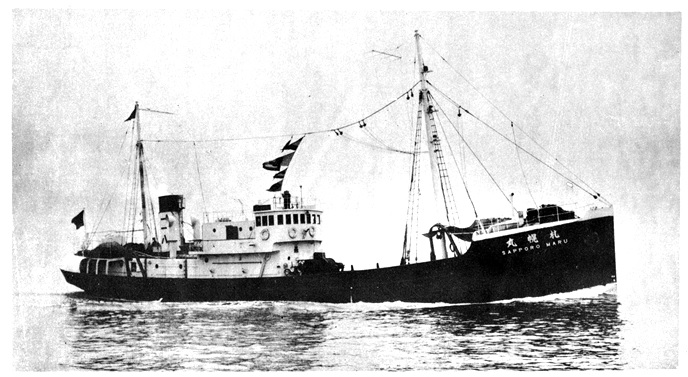KYURYOSEN!
 (SAPPORO MARU, prewar)
(SAPPORO MARU, prewar)
IJN SAPPORO MARU:
Tabular Record of Movement
© 2017 Gilbert Casse, Berend van der Wal and Peter Cundall
9 August 1930:
Hikoshima. Laid down by Mitsubishi Zosen K.K. shipyard as a 361-tons trawler (FV) for Kyodo Gyogyo K.K.
24 October 1930:
Launched and named SAPPORO MARU.
25 November 1930:
Completed with Gross Registered Tonnage (GRT) and Net Registered Tonnage (NRT) respectively of 361-tons and 151-tons. Registered at Tobata. [1]
5 December 1930:
Kyodo Gyogyo K.K receives a steamer trawl fishing permit available for 10 years. Operation areas include: (A) Tokai and Yellow Sea, (B) Bering Sea E of 160E, within the line from Cape Olutluski to Cape Nawalin excluding sea level within 60 depths of water, (C) South China Sea.
Harvesting ports are: Tobata, Shimonoseki, Nagasaki, Osaka, Aomori and Hakodate.
1 June ~ 31 August 1931:
Operations in Tokai and Yellow Sea are forbidden.
1 March 1932:
Harvesting ports are changed to: Tobata, Shimonoseki, Nagasaki, Osaka, Aomori, Hakodate and Hong Kong.
1 July 1934:
Her owners are restyled to Hiroshi Gyogyo K.K.
16 August 1934:
Her owners are restyled back to Kyodo Gyogyo K.K.
1935:
Her GRT and NRT are respectively changed to 397-tons and 198-tons. [1]
26 August 1936:
Kyodo Gyogyo K.K steamer trawl fishing permit is renewed. Operation areas include: (A) Tokai and Yellow Sea, (B) South China Sea.
Harvesting ports are: Tobata, Shimonoseki, Nagasaki, Osaka and Hakodate.
26 April 1937:
Nippon Suisan K.K. receives a steamer trawl permit. Operation areas include: (A) Tokai and Yellow Sea, (B) South China Sea, (C) Offshore Mexican coastal areas including California Gulf, Central America offshore coast from Guatemala to Cape Mariato, Panama, (D) West of 80W in Mexico Gulf and the Caribbean Sea.
Harvesting ports are: Tobata, Shimonoseki, Nagasaki, Osaka, Hong Kong, Los Angeles, Balboa, Cristobal, Manzanillo, Galveston, New Orleans, Masarang, Bellacruise, Tampico and the Mexican Government’s Authorized Ports of Islands.
7 May 1937:
Ownership is changed to Nippon Suisan K.K.
6 May 1939:
Arrives at Humen, Pearl River estuary, China.
10 May 1939:
0915 ~ 1140 comes alongside to starboard of auxiliary gunboat DELHI MARU and replenishes her with fresh food.
22 September 1939:
1400 ~ 1500 comes alongside to starboard of auxiliary gunboat DELHI MARU and replenishes her with fresh food.
23 September 1939:
Departs Humen.
9 October 1939:
Arrives at Ling-Ting (Lintin) Island (now Nei Lingding Dao), Pearl River estuary, China.
9 October 1939:
1652 ~ 1816 comes alongside to starboard of auxiliary gunboat DELHI MARU and replenishes her with fresh food. Departs Ling-Ting Island later that day.
24 May 1942:
Departs Tateyama in an unnumbered northbound convoy also consisting of IJN auxiliary transport SHINSEI MARU No. 18, IJA transports AMAHO, FUKOKU and NICHIUN MARUs and IJN requisitioned (B-APK) HEIWA MARU, escorted by survey ship KOMAHASHI and minelayer UKISHIMA. Late that day when 55 degrees off Katsuura, KOMAHASHI is detached and returns to Yokosuka.
31 May 1942:
Arrives at Paramushiro, Kuriles.
31 March 1943:
Ownership is changed Nihon Kaiyo Gyogyo Tosei K.K.
5 December 1943:
Requisitioned by the IJN.
20 January 1944:
Registered as an auxiliary stores ship attached to the Yokosuka Naval District under instruction No. 156. Attached to Vice Admiral Kobayashi Masashi’s (38) Fourth Fleet as an auxiliary stores ship Otsu category. [2]
4 May 1944:
SW Truk, north of Fefan Island, Truk Lagoon. Sunk by USN TF-58 aircraft at 07-18N, 151-21E. Two crewmen are KIA.
Authors' Notes:
[1] NRT is a ship's cargo volume capacity expressed in "register tons", one of which equals to a volume of 100 cubic feet (2.83 m3). It is calculated by subtracting non-revenue-earning spaces i.e. spaces not available for carrying cargo, for example engine rooms, fuel tanks and crew quarters, from the ship's gross register tonnage (GRT). Net register tonnage (NRT) is not a measure of the weight of the ship or its cargo, and should not be confused with terms such as deadweight tonnage or displacement.
[2] There were two categories of Kyuryosen. (Ko) category with an IJN Captain as supervisor aboard and (Otsu) category without.
Thanks go to Gengoro S. Toda of Japan.
- Berend van der Wal, Gilbert Casse and Peter Cundall.
Back to the Storeships Page





